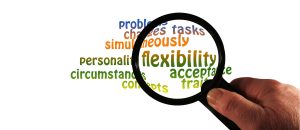 Do you miss those days when you could eat your favorite food and not feel bad? You can still do that and avoid the programmed mentality the diet culture has created. Food flexibility is based on listening to your body. It takes the bad and good labels away from food and turns it back to just plain food, sustenance for the body that you can enjoy. It also helps prevent the cycles of deprivation and binging or the defeat you feel when you’ve eaten a “forbidden” food.
Do you miss those days when you could eat your favorite food and not feel bad? You can still do that and avoid the programmed mentality the diet culture has created. Food flexibility is based on listening to your body. It takes the bad and good labels away from food and turns it back to just plain food, sustenance for the body that you can enjoy. It also helps prevent the cycles of deprivation and binging or the defeat you feel when you’ve eaten a “forbidden” food.
The first step in developing food flexibility is understanding your internal food rules.
You may not even realize that you’ve created food rules or know where you developed those ideas once you do. Every time you eat, become aware of your self-talk. That will lead you to your internal food rules. Do these have power over you and limit your enjoyment of food? Do you ever go against them? If so, how do you feel when you do? Once you know the rules, give yourself permission to break them.
Learn to eat intuitively.
Once you understand the rules you’ve internalized and given yourself permission to break them, you need to learn to eat intuitively, accepting that foods aren’t good or bad. Intuitive eating means listening to your body. Pay attention to how you feel after you eat a specific food or eat at certain times. You might feel energetic after a certain type of meal or wake up feeling bloated after eating a big snack at night. Look for the foods and eating patterns that make you feel your best.
Food flexibility focuses on feeling good, listening to your body, and avoiding restriction.
Learning to eat healthier is part of food flexibility. It’s all about enjoying the food you eat and making smarter choices. When you permit yourself to eat the food you crave or listen to your body when you do, you won’t feel denied the pleasure of consuming it. You also won’t feel the shame that you would otherwise feel when eating food previously restricted. Taking the negative emotions out of food allows you to increase the pleasure, which can prevent overeating later.
- Why does food flexibility work? Any type of restriction will increase the desire for the food restricted. Often one bite is enough to satisfy that desire, especially if you’re in tune with your body.
- If you’re uncomfortable eating without rules, identify what you like about a certain food that was previously restricted. Look for the same quality in other, healthier options. The crunch from pretzels can be replaced with crisp celery.
- Sometimes, food flexibility has roadblocks. If you’re constantly eating food with added sugar, your body may tell you to eat more. Sugar is addictive. The more you eat, the more you need to get the sweet flavor.
- Healthy eating is all about being flexible but making smarter decisions when you do eat. However, if you’re really craving something unhealthy, you can eat it, and it’s not the end of the world or your plan of healthy eating.
For more information, contact us today at LIV Fitness
